Why do managers encourage people to use techniques such as Natural Ventilation? International estimation by the US Office of Technology Assessment presents that developing countries have the potential to reduce their electricity generation if energy is utilized more effectively. Ventilation, particularly, natural ventilation is one of these methods. It is a way of providing new air to a home or office-room using passive forces, normally by wind velocity or pressure externally and internally differences.
The flow of air between the outside and the inside of a structure is known as natural ventilation. Natural ventilation is caused by two natural forces: pressure differences caused by the wind blowing around the building (wind-driven ventilation) and temperature variations (‘stack effect’ ventilation). The use of HVAC Products necessitates the use of natural ventilation. Natural Ventilation systems are available from a variety of Suppliers and Companies, as well as manufacturers and distributors, and there are many Natural Ventilation systems for sale on Linquip.
There is a complete list of Natural Ventilation services on the Linquip website that covers all of your HVAC needs. Linquip vendors can assist you with this. Please contact Natural Ventilation Experts in Linquip to learn more about how to connect with a diverse group of service providers who consistently deliver high-quality products.
There are two goals for this post. The first is to supply a reasonable, general, and up-to-date description of natural ventilation theory and measurement. The second introduces how theory and measurement can be operated to the modeling of naturally ventilated houses.
What is Natural Ventilation
Approximately all historical buildings were naturally ventilated. With more knowledge of the cost and environmental influences of energy usage, natural ventilation has become an increasingly noteworthy method. This is an appropriate solution for decreasing energy usage and cost and supplying allowable inner environmental state, and keeping a healthy and convenient indoor climate rather than the more predominant method of using mechanical ventilation. In desirable climates, natural ventilation can be employed as a substitution for air-conditioning plants, preserving 10%–30% of entire energy utilization.
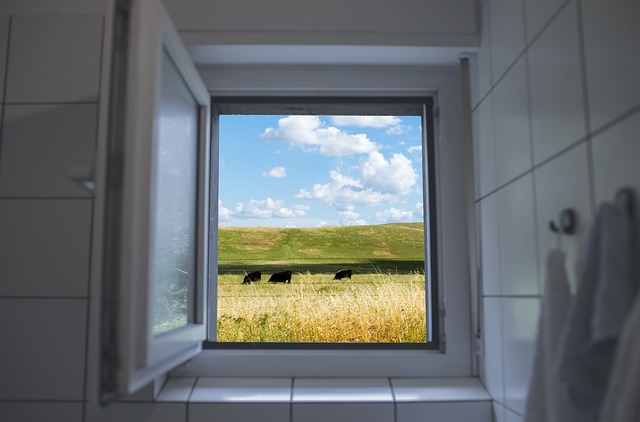
Natural ventilation is the procedure of entering fresh air into a home from outside. This new air, forces the dirty, warm air in the rooms out by the opening in the roof. This can be operated without mechanical assistance. While that was a brief introduction, its practical application and usage is much more involved. Natural ventilation is one of the most practical techniques to decrease energy usage in buildings. It utilizes the natural power of wind and buoyancy to enter fresh air and spread it in buildings for the occupants. Natural ventilation is operated by pressure varieties between one section of a building and another, or between the outside and inside.
Natural ventilation can provide a sufficient supply of breathing air, adequate ventilation of pollutants, enough thermal conditioning, and humidity waste through a well-connection to the dynamics of the environment. Designers usually select natural ventilation because it decreases carbon production and is cheaper to install and run than full mechanical ventilation. It also needs less preservation, modifies the occupant’s anticipations, and presents more control of their environment. This type of Ventilation provides free night cooling, decreasing daytime temperatures. Natural Ventilation and human comfort are related together. If you want to see their relationship briefly, click here.
Why Is Natural Ventilation Important?
Natural ventilation aids in the maintenance of a healthy lifestyle. The oxygen in the fresh air, for example, can improve your blood pressure, heart rate, and energy levels. It helps to boost your immune system. Higher serotonin levels also make you feel more rested and rejuvenated.
What Are Natural Ventilation General Rules?
Natural ventilation is the process of naturally delivering and removing air from an interior space without the assistance of a fan or other mechanical device. It provides ventilation and space cooling by using external airflow induced by pressure differences between the building and its surroundings.
Types of Natural Ventilation
There are basically two kinds of Natural Ventilation that happen naturally in buildings. First is wind-based ventilation (also introduced as cross ventilation), and the second is Buoyancy-operated (also known as stack-effect) ventilation. Nevertheless, choosing the best method to design and operate a ventilation system is based on various issues. Both the effectiveness and design considerations include some different parameters, which are explained below.
The effectiveness of natural ventilation
The impact of Natural Ventilation can increase in the building according to your consideration of the following matters:
- Prevailing wind velocity and direction
- Building conditions and orientation
- Window sizing, location, and functioning
- Surrounding environment
- Outdoor temperature and moisture
Design Considerations
If you’re thinking about designing natural ventilation in your new building, you should notice the following basic design techniques:
- External components
- Window types and verification
- Building appearance and dimensions
- Ridge vents
- Building orientation and position
- Air inlets and outlets
There are two frequently employed natural ventilation methods:
Wind-Based Ventilation (Cross-Ventilation)
Moving wind near a building will produce different sections of low and high pressure. The windward part of the house is an area that is high pressure, while the leeward part & roof are low pressure. Placing different types and sizes of openings in the low and high-pressure sections can force air to transfer through the building at an increased rate and in the desirable direction.
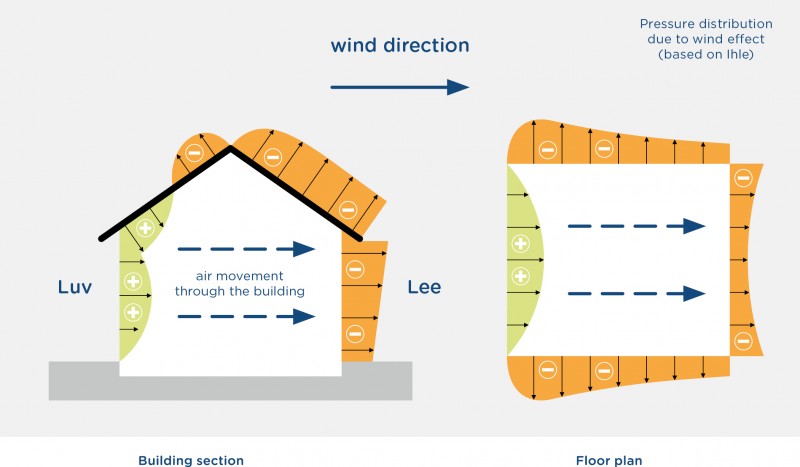
The simplest method to know wind-driven or wind-based ventilation is to look at an open window. Fresh air enters through one side, transfers throughout the house, and then exits through the opposite side, forcing the stale warm air out that was in the building. Furthermore, this is an attractive, low-cost ventilation solution in specific applications. Visit here to see a comprehensive explanation of this type of Natural Ventilation.
Nevertheless, it should be considered that wind-based ventilation isn’t often ideal in locations where there’s a lot of dust or contamination. It also doesn’t operate in places where the wind is not desirable, i.e., wind moves in the opposite direction and has no impact.
Buoyancy-Driven Ventilation (The Stack Effect)
This type of Natural Ventilation seems complex, but it works fundamentally like a fireplace. Because warm air goes up and cool air remains low, this procedure forces warm air to rise.
The heat produced in buildings goes up towards the ceiling. In huge buildings, where the construction is of noticeable height, the natural trend of warm air to rise produces air transfer throughout the whole of the building. This is what is usually introduced as the stack effect or thermal buoyancy. Warm air goes up through the building and exits via the natural ventilator. The wall openings at the floor level permit cool air to come in, taking the place of the warm air that exits.
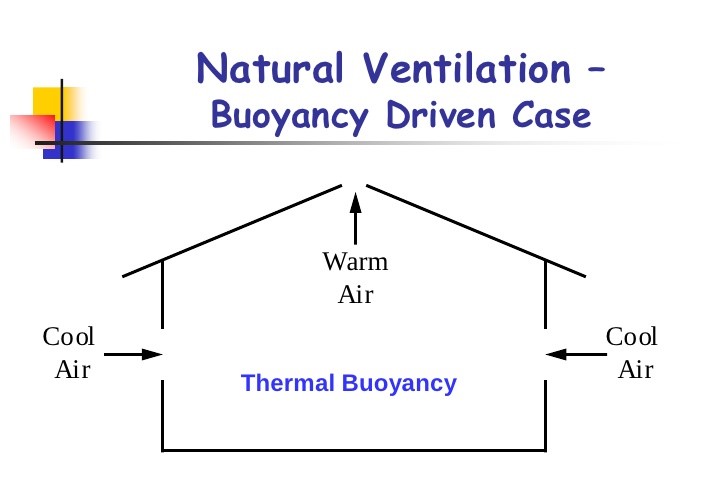
The tall roofs of industrial structures produce considerable differences in pressures and temperatures; therefore, industrial places are perfect locations for gravity ventilation systems. Using these differences can convey air up and out of the building naturally.
In contrast to cross-ventilation, this procedure can still run on cool and calm days. For natural ventilation, buoyancy-driven ventilation is the right option all year-round.
Combined Ventilation
Natural Ventilators can also be combined with powered ventilation to keep the entire building convenient throughout the day.
Powered ventilation is the only choice in some locations. Applications that employ chemicals or have lower ceilings height or just don’t generate quite adequate heat need powered ventilation. Eventually, there are many explanations about why powered ventilation may be vital. Some plant managers utilize systems that employed a natural solution for larger sections and powered ventilation for operation rooms and smaller areas throughout their locations.
As a result, Combined Ventilation presents you with the best solution. Finally, you’ll decrease operating payments, keep air quality comfort, and make sure you’re following all important safety and healthy directions in your place.
Advantages of Natural Ventilation
It is hard to make certain explanations about the advantages and disadvantages of natural ventilation contrasted to mechanical systems, nearly because they are influenced by some external conditions such as the utilization of the building and the climate-changing. Nevertheless, this question cannot be passed in this post about natural ventilation, and some general explanations can be presented.
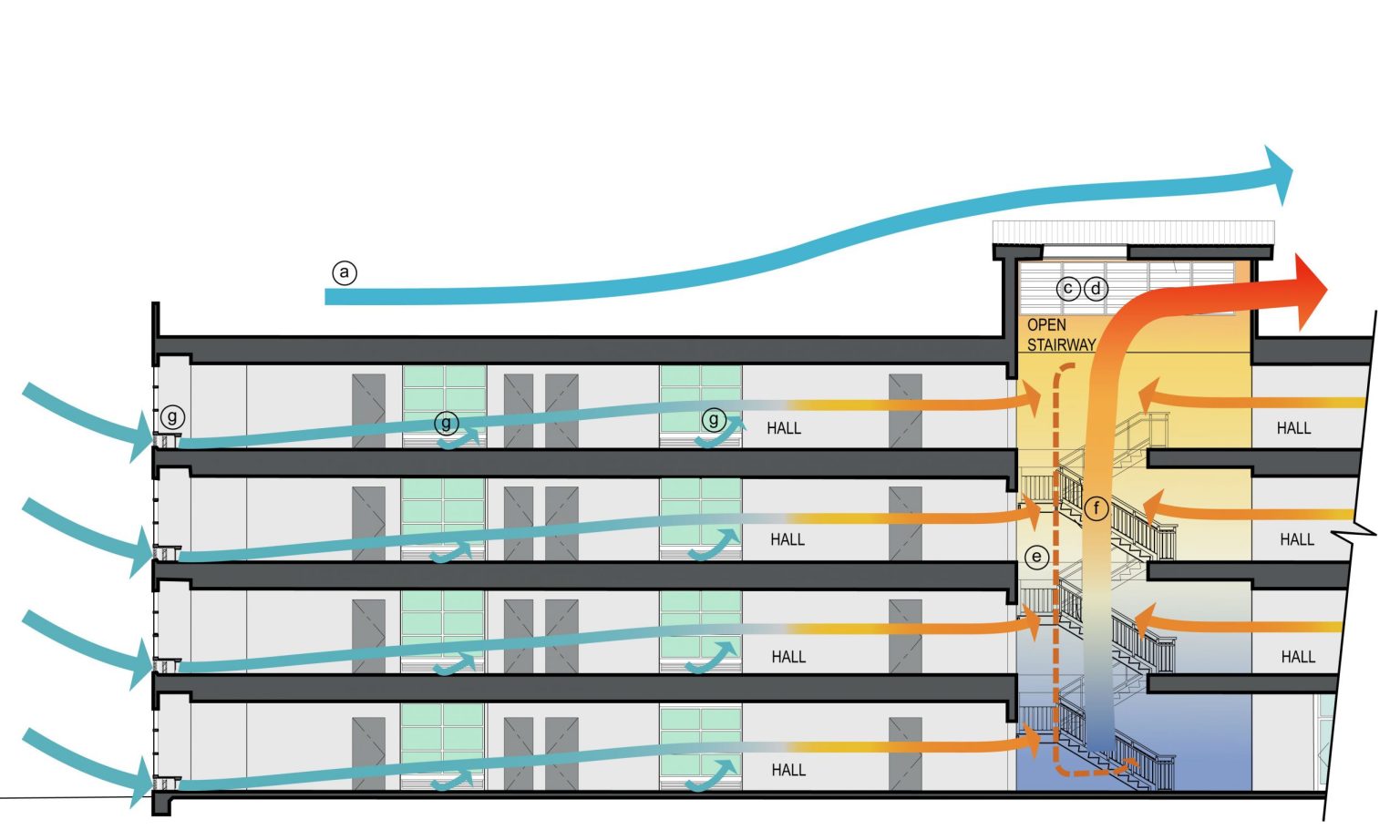
If well fixed and maintained, there are several benefits of a natural ventilation system, compared with mechanical ones. Natural ventilation can practically supply a high ventilation level more economically due to the employment of natural powers and large openings. They are more energy effective, especially if heating is not needed. The systems which are well-designed could be utilized to provide higher levels of daylight.
The other principal advantage contended for natural ventilation is that it helps keep a sustainable building environment. Considering thousands of years that natural ventilation has existed, this claim is hard to explain. One contributory element here is that natural system needs no electrical energy for fans, which can form 25% of the electrical energy usage in a mechanically ventilated structure.
There are also records that occupants of the house want to control their environment and prefer not to be entirely isolated from the external environment. Natural Ventilation can bring about both these requirements, while a conventional air-conditioning device does not.
In general, the advantage of natural ventilation is its capability to supply a very high air-change level at a low cost, with a very ordinary system. Although the air-change rate can change considerably, buildings with new ventilation systems (that are modeled and worked appropriately) can obtain very high air-change levels by natural power, which can considerably be greater in quantity than minimum ventilation needs.
Disadvantages of Natural Ventilation
There are some disadvantages to natural ventilation systems, which are discussed below.
Natural ventilation is changeable and based on outside climatic situations comparative to the inside environment. The two motive forces that produce the airstream rate, including temperature difference and wind, change accidentally. Natural ventilation may be hard to control, with airstream being uncomfortably heavy in some locations and static in others.
There can be some problems in monitoring the airstream direction due to the lack of a stable negative pressure; pollution of corridors and adjacent rooms is, therefore, a hazard.
Natural ventilation prevents the usage of particulate filters. Security, cultural, and climate standards may command that windows and vents remain closed; in these situations, ventilation level may be much lower.
It only operates when natural powers are available; when a high ventilation level is needed, the requirement for the accessibility of natural power is also high.
Natural ventilation systems usually do not operate as anticipated, and normal function may be interrupted for different reasons such as doors or windows not open, equipment destruction, utility service interruption (if it is a high-tech system), inferior modeling, incorrect management, or poor preservation.
Although the preservation cost of natural ventilation systems can be very low, if a ventilation system cannot be set properly or preserved due to a shortage of funds, its operation can be changed, causing an increase in the hazard of the transfer of airborne pathogens.
Another disadvantage of natural ventilation is that it is restricted in the extent to which it can supply cooling in hot climates and especially ones that are also moist. For this system to be allowable in some climates, it is necessary to join it with some form of tolerable (low-energy) cooling system.
Natural ventilation does not need extra space for plant rooms or networks of ducts, but some places are often needed for stacks (chimneys, atria). The specific disadvantage is that errors in modeling a natural system may be more difficult to revise.
Other feasible problems, such as air contamination, insect vectors, noise, and security, also require to be noticed. Nevertheless, these problems can be overcome, for instance, by using better modeling or hybrid (mixed-mode) ventilation.
Download Natural Ventilation PDF
Read More In Linquip
- 5 Types of Ventilation and All We Should Know About
- HRV vs ERV: Choosing Between Remarkable Types of Ventilation Systems
- Stack Ventilation: A Comprehensive Overview of The Principles and Applications
- Ventilation Design: Spectacular Tips You Need to Know Before
- Heat Recovery Ventilation (HRV): Definition, Advantages & Installation
- Home Ventilation: Necessity, Types, and Strategies
- Energy Recovery Ventilator (ERV): Installation, Types & Advantages
- Mechanical Ventilation System, Types, Advantages and Disadvantages

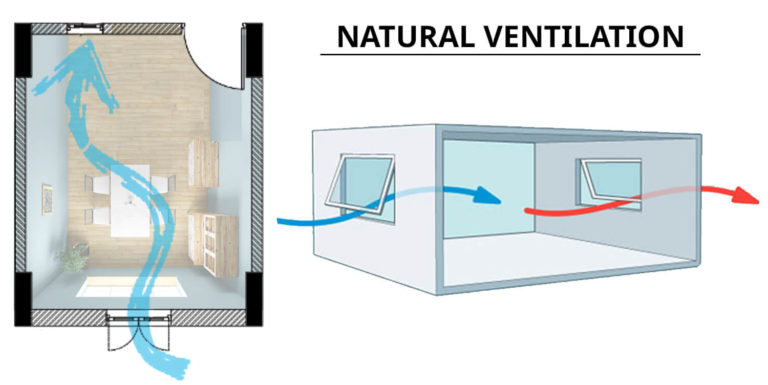


Am really enjoying this website and it is very good.
Thank you for your comment.